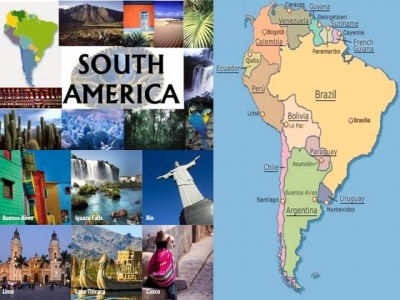
SOUTH AMERICA
Rich in history, language, and culture, South America is a vibrant place. Nature has made its mark in the trees of the Amazon rainforest, while ancient civilizations have left theirs in the city of Machu Picchu in the Andes Mountains. The influence of Spanish and Portuguese colonization remains in the languages, while samba sounds and traditional tangos resonate at the festivals.
- FOOD
Maize is a staple food used in bread and cakes stuffed with meat or cheese. Potatoes, squash, rice, and different types of beans are also meal-time favourites. Peruvians love spicy foods, so hot chilli peppers are often on the menu.
- TREES AND PLANTS
A large part of the continent is pampas (grassy plain), which is one of the richest grazing areas in the world. Variety comes from the Amazon rainforest, where about 40,000 species of plants flourish. Unique plants grow in Venezuela’s sandstone hills and Chile’s Atacama Desert, where species have adapted to survive the lack of water.
- INCAS
The Incas were the last great civilization to emerge in South America. During the 12th century, expert architects created their capital at Cusco. By the 15th century, their empire had spread from Equador through Peru to Chile. Hearing of great riches, the Spanish arrived in 1532 to set up colonies and ended the Inca reign.
- PHYSICAL FEATURES
Three contrasting landscapes dominate South America. From the west rise the towering peaks of the Andes Mountains, leading down to the Pacific Ocean. In the northeast is the dense Amazon rainforest, which spreads across half of Brazil. To the south are vast, grassy plains called the pampas (which means “flat” in Spanish).
- CROPS
Brazil produces one-third of the world’s coffee, while Ecuador’s climate is ideal for growing tomatoes and bananas. Steep hillsides are terraced for farming in Chile and Peru, where potatoes are planted on the higher slopes of the Andes, and corn is sown lower down.
- CULTURE
Music and dance form the heart of South American culture. The rhythmic dance of the samba is a notable highlight of Rio de janeiro’s famous five-day carnival, which features spectacular parades and parties in Brazil’s capital. Another common sight is football games on the streets and beaches.
- WILDLIFE
The Amazon is the world’s largest rainforest and could contain 10 per cent of all animal species. Jaguars, sloths, and tapirs live under the tree canopy, while the forest floor teems with snakes, lizards, and insects. Colourful toucans, macaws, and kingfishers swoop over the River Amazon, where dolphins and turtles swim.
Picture Credit : Google




